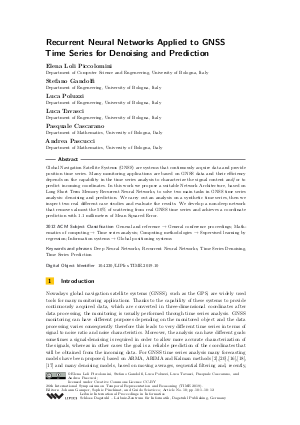Recurrent Neural Networks Applied to GNSS Time Series for Denoising and Prediction
Authors Elena Loli Piccolomini, Stefano Gandolfi, Luca Poluzzi, Luca Tavasci, Pasquale Cascarano, Andrea Pascucci
-
Part of:
Volume:
26th International Symposium on Temporal Representation and Reasoning (TIME 2019)
Part of: Series: Leibniz International Proceedings in Informatics (LIPIcs)
Part of: Conference: International Symposium on Temporal Representation and Reasoning (TIME) - License:
 Creative Commons Attribution 3.0 Unported license
Creative Commons Attribution 3.0 Unported license
- Publication Date: 2019-10-07
File

PDF
LIPIcs.TIME.2019.10.pdf
- Filesize: 1.63 MB
- 12 pages
Document Identifiers
Subject Classification
ACM Subject Classification
- General and reference → General conference proceedings
- Mathematics of computing → Time series analysis
- Computing methodologies → Supervised learning by regression
- Information systems → Global positioning systems
Keywords
- Deep Neural Networks
- Recurrent Neural Networks
- Time Series Denoising
- Time Series Prediction
Metrics
- Access Statistics
-
Total Accesses (updated on a weekly basis)
0PDF Downloads0Metadata Views
Abstract
Global Navigation Satellite Systems (GNSS) are systems that continuously acquire data and provide position time series. Many monitoring applications are based on GNSS data and their efficiency depends on the capability in the time series analysis to characterize the signal content and/or to predict incoming coordinates. In this work we propose a suitable Network Architecture, based on Long Short Term Memory Recurrent Neural Networks, to solve two main tasks in GNSS time series analysis: denoising and prediction. We carry out an analysis on a synthetic time series, then we inspect two real different case studies and evaluate the results. We develop a non-deep network that removes almost the 50% of scattering from real GNSS time series and achieves a coordinate prediction with 1.1 millimeters of Mean Squared Error.
Cite As Get BibTex
Elena Loli Piccolomini, Stefano Gandolfi, Luca Poluzzi, Luca Tavasci, Pasquale Cascarano, and Andrea Pascucci. Recurrent Neural Networks Applied to GNSS Time Series for Denoising and Prediction. In 26th International Symposium on Temporal Representation and Reasoning (TIME 2019). Leibniz International Proceedings in Informatics (LIPIcs), Volume 147, pp. 10:1-10:12, Schloss Dagstuhl – Leibniz-Zentrum für Informatik (2019)
https://doi.org/10.4230/LIPIcs.TIME.2019.10
BibTex
@InProceedings{lolipiccolomini_et_al:LIPIcs.TIME.2019.10,
author = {Loli Piccolomini, Elena and Gandolfi, Stefano and Poluzzi, Luca and Tavasci, Luca and Cascarano, Pasquale and Pascucci, Andrea},
title = {{Recurrent Neural Networks Applied to GNSS Time Series for Denoising and Prediction}},
booktitle = {26th International Symposium on Temporal Representation and Reasoning (TIME 2019)},
pages = {10:1--10:12},
series = {Leibniz International Proceedings in Informatics (LIPIcs)},
ISBN = {978-3-95977-127-6},
ISSN = {1868-8969},
year = {2019},
volume = {147},
editor = {Gamper, Johann and Pinchinat, Sophie and Sciavicco, Guido},
publisher = {Schloss Dagstuhl -- Leibniz-Zentrum f{\"u}r Informatik},
address = {Dagstuhl, Germany},
URL = {https://drops.dagstuhl.de/entities/document/10.4230/LIPIcs.TIME.2019.10},
URN = {urn:nbn:de:0030-drops-113687},
doi = {10.4230/LIPIcs.TIME.2019.10},
annote = {Keywords: Deep Neural Networks, Recurrent Neural Networks, Time Series Denoising, Time Series Prediction}
}
Author Details
References
- Y Bengio, Patrice Simard, and Paolo Frasconi. Learning Long-Term dependencies with Gradient Descent is Difficult. IEEE transactions on neural networks / a publication of the IEEE Neural Networks Council, 5:157-66, February 1994. URL: https://doi.org/10.1109/72.279181.
-
Peter J. Brockwell and Richard A. Davis. Introduction to Time Series and Forecasting. Springer New York, 1996.

- David E. Rumelhart, Geoffrey E. Hinton, and Ronald J. Williams. Learning Representations by Back Propagating Errors. Nature, 323:533-536, October 1986. URL: https://doi.org/10.1038/323533a0.
-
Claudio Gallicchio. Short-Term Memory of Deep RNN. In Proceedings for European Symposium on Artificial Neural Networks, February 2018.

-
Stefano Gandolfi, Luca Poluzzi, and Luca Tavasci. Structural Monitoring Using GNSS Technology and Sequential Filtering. In Proceedings for FIG Working Week, May 2015.

- Alex Graves. Generating Sequences With Recurrent Neural Networks. ArXiv: 1308.0850, August 2013. URL: http://arxiv.org/abs/1308.0850.
- Alex Graves, Navdeep Jaitly, and Abdel-rahman Mohamed. Hybrid speech recognition with Deep Bidirectional LSTM. In 2013 IEEE Workshop on Automatic Speech Recognition and Understanding, ASRU 2013 - Proceedings, pages 273-278, December 2013. URL: https://doi.org/10.1109/ASRU.2013.6707742.
- Alex Graves, Abdel-rahman Mohamed, and Geoffrey Hinton. Speech Recognition with Deep Recurrent Neural Networks. ICASSP, IEEE International Conference on Acoustics, Speech and Signal Processing - Proceedings, 38, March 2013. URL: https://doi.org/10.1109/ICASSP.2013.6638947.
- Sepp Hochreiter. The Vanishing Gradient Problem During Learning Recurrent Neural Nets and Problem Solutions. Int. J. Uncertain. Fuzziness Knowl.-Based Syst., 6(2):107-116, April 1998. URL: https://doi.org/10.1142/S0218488598000094.
- Sepp Hochreiter and Jürgen Schmidhuber. Long Short-term Memory. Neural computation, 9:1735-80, December 1997. URL: https://doi.org/10.1162/neco.1997.9.8.1735.
-
K.M. Hornik, M. Stinchcomb, and H. White. Multilayer feedforward networks are universal approximator. IEEE Transactions on Neural Networks, 2, January 1989.

- Changhui Jiang, Shuai Chen, Yuwei Chen, Boya Zhang, Ziyi Feng, Hui Zhou, and Yuming Bo. A MEMS IMU De-Noising Method Using Long Short Term Memory Recurrent Neural Networks (LSTM-RNN). Sensors, 18:3470, October 2018. URL: https://doi.org/10.3390/s18103470.
- Hee-Un Kim and Tae-Suk Bae. Deep Learning-Based GNSS Network-Based Real-Time Kinematic Improvement for Autonomous Ground Vehicle Navigation. Journal of Sensors, 2019:1-8, March 2019. URL: https://doi.org/10.1155/2019/3737265.
-
Diederik Kingma and Jimmy Ba. Adam: A Method for Stochastic Optimization. International Conference on Learning Representations, December 2014.

- José Lima and J Casaca. Smoothing GNSS Time Series with Asymmetric Simple Moving Averages. Journal of Civil Engineering and Architecture, 6, June 2012. URL: https://doi.org/10.17265/1934-7359/2012.06.013.
-
X. Luo, M. Mayer, and B. Heck. Analysing Time Series of GNSS Residuals by Means of AR(I)MA Processes. In VII Hotine-Marussi Symposium on Mathematical Geodesy, pages 129-134. Springer Berlin Heidelberg, 2012.

- Xiaoguang Luo. GPS Stochastic Modelling - Signal Quality Measures and ARMA Processes. Springer, January 2013. URL: https://doi.org/10.1007/978-3-642-34836-5.
- Ping-Feng Pai and Chih-Sheng Lin. A hybrid ARIMA and support vector machines model in stock price forecasting. Omega, 33(6):497-505, 2005. URL: https://EconPapers.repec.org/RePEc:eee:jomega:v:33:y:2005:i:6:p:497-505.
- Yuelei Xiao and Yang Yin. Hybrid LSTM Neural Network for Short-Term Traffic Flow Prediction. Information, 10:105, March 2019. URL: https://doi.org/10.3390/info10030105.
- Jingzhou Xin, Jianting Zhou, Simon Yang, Xiaoqing Li, and Yu Wang. Bridge structure deformation prediction based on GNSS data using Kalman-ARIMA-GARCH model. Sensors (Basel, Switzerland), 18, January 2018. URL: https://doi.org/10.3390/s18010298.
